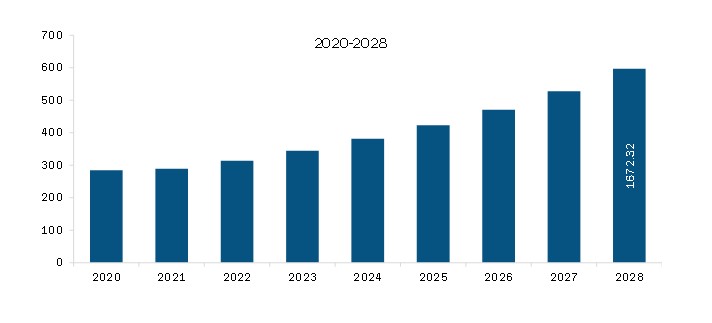The Europe packaging robots market is expected to reach US$ 1,672.32 million by 2028 from US$ 787.04 million in 2021; it is estimated to grow at a CAGR of 11.37% from 2021 to 2028.
Major factors driving the market growth are the rising demand for packaging robots from several industries and the growing demand for reducing the overall operational costs across the packaging sector. However, the high deployment cost of packaging robots hampers the market growth.
Packaging methods for consumer-packaged goods must be precise and repeatable. Companies that use robotics in their packaging lines can improve throughput, efficiency, and quality. Individual packaging at high-cycle rates might be difficult. Robotics has proven to have a high return on investment in various applications, such as raw product handling, primary packaging, secondary packaging, and palletizing. Moreover, product branding and packaging are critical for producers to be competitive in today's market. Packaging, brand name, content, and pricing influence the purchase patterns of customers. Also, counterfeit items are a common problem for manufacturers in the food & beverages, pharmaceuticals, and FMCG industries. Packaging robots are reliable and give high-quality branding information via labeling. After products are packaged, a unique identification code is generated, which aids in product tracking along the supply chain. Moreover, flexibility is the main benefit of robotics in the packaging sector. Line machinists can adjust the contour of a case or pallet load with the push of a button. This highlights the flexibility needed to satisfy trade customers who need tailored cargoes while not losing the accompanying speed. Furthermore, robotic packaging systems, such as pick-and-place robots, are equipped with slim arms and a wide reach, as well as solid repeatability and precision tooling, enabling them to be exceedingly precise and accurate. Owing to their high precision, they're a good fit for various packaging and supply chain tasks. Also, product quality and cycle time can be improved using robot packaging equipment. As robotic actions are regulated, their consequences are always consistent, which enhances packing quality. The packaging procedures can run smoothly because of this consistency.
The impact of COVID-19 outbreak differed from country to country across Europe as selected countries witnessed an increase in the number of COVID-19 cases and subsequently attracted strict and extended lockdown periods or social isolation. The automotive industry in Europe was severely hit and witnessed an overall automotive production decline by over 20% from 2019 to 2021 due to severe supply chain disruption caused by lockdowns. The automotive industry is the largest end-use market for industrial robots. Hence, decline in the growth of the industry lowered the demand for industrial automation solutions during 2020 as companies halted significant investments. However, with the growing demand for electric vehicles in the region, the outlook post COVID-19 pandemic for the automotive industry seems favorable. A few of the other sectors that deploy robots are electric/electronics, metals and machinery, food & beverages also witnessed a sharp decline in the demand. The demand is expected to recover by 2022, with companies investing in making operations efficient and productive.
Europe Packaging Robots Market Revenue and Forecast to 2028 (US$ Mn)
Europe Packaging Robots Market Revenue and Forecast to 2028 (US$ Mn)

- Sample PDF showcases the content structure and the nature of the information with qualitative and quantitative analysis.
- Request discounts available for Start-Ups & Universities
EUROPE PACKAGING ROBOTS MARKET SEGMENTATION
- Sample PDF showcases the content structure and the nature of the information with qualitative and quantitative analysis.
- Request discounts available for Start-Ups & Universities
By Industry Verticals
- Food & Beverages
- Pharmaceuticals
- Consumer Electronics
- Others
By Application
- Primary Packaging
- Secondary Packaging
- Tertiary Packaging
By Country
- Germany
- Italy
- France
- UK
- Russia
- Rest of Europe
Company Profiles
- ABB
- Fanuc Corporation
- Krones AG
- Kuka AG
- Mitsubishi Electric Corporation
- Syntegon Technology GmbH (Bosch Packaging Technology)
- Schneider Electric SE
- Yaskawa Electric Corporation

Report Coverage
Revenue forecast, Company Analysis, Industry landscape, Growth factors, and Trends

Segment Covered
This text is related
to segments covered.

Regional Scope
North America, Europe, Asia Pacific, Middle East & Africa, South & Central America

Country Scope
This text is related
to country scope.
TABLE OF CONTENTS
1. Introduction
1.1 Study Scope
1.2 The Insight Partners Research Report Guidance
1.3 Market Segmentation
2. Key Takeaways
3. Research Methodology
3.1 Coverage
3.2 Secondary Research
3.3 Primary Research
4. Packaging Robots Market Landscape
4.1 Market Overview
4.2 PEST Analysis
4.3 Expert Opinions
5. Packaging Robots Market – Key Market Dynamics
5.1 Market Drivers
5.1.1 Rising Demand for Packaging Robots from Several Industries
5.1.2 Growing Demand for Reducing the Overall Operation Costs Across Packaging Sector
5.2 Market Restraints
5.2.1 High Deployment Cost of Packaging Robots
5.3 Market Opportunities
5.3.1 Increased Demand for High Degree Automation
5.4 Future Trends
5.4.1 Intelligent Modernization and Adoption of Vision Sensor Technology
5.5 Impact Analysis of Drivers and Restraints
6. Packaging Robots Market –Europe Analysis
6.1 Packaging Robots Market Europe Overview
6.2 Packaging Robots Market –Europe Revenue and Forecast to 2028 (US$ Million)
7. Packaging Robots Market Analysis – By Industry Verticals
7.1 Overview
7.2 Packaging Robots Market Breakdown, By Industry Verticals (2020 and 2028)
7.3 Food & Beverages
7.3.1 Overview
7.3.2 Food & Beverages: Packaging Robots Market Revenue and Forecast to 2028 (US$ Million)
7.4 Pharmaceuticals
7.4.1 Overview
7.4.2 Pharmaceuticals: Packaging Robots Market Revenue and Forecast to 2028 (US$ Million)
7.5 Consumer Electronics
7.5.1 Overview
7.5.2 Consumer Electronics: Packaging Robots Market Revenue and Forecast to 2028 (US$ Million)
7.6 Others
7.6.1 Overview
7.6.2 Others: Packaging Robots Market Revenue and Forecast to 2028 (US$ Million)
8. Packaging Robots Market Analysis – By Application
8.1 Overview
8.2 Packaging Robots Market Breakdown, By Application (2020 and 2028)
8.3 Primary Packaging
8.3.1 Overview
8.3.2 Primary Packaging: Packaging Robots Market Revenue and Forecast to 2028 (US$ Million)
8.4 Secondary Packaging
8.4.1 Overview
8.4.2 Secondary Packaging: Packaging Robots Market Revenue and Forecast to 2028 (US$ Million)
8.5 Tertiary Packaging
8.5.1 Overview
8.5.2 Tertiary Packaging: Packaging Robots Market Revenue and Forecast to 2028 (US$ Million)
9. Packaging Robots Market – Europe Analysis
9.1 Europe: Packaging Robots Market
9.1.1 Europe: Packaging Robots Market – Revenue and Forecast to 2028 (US$ Million)
9.1.2 Europe: Packaging Robots Market- by Industry Verticals
9.1.3 Europe: Packaging Robots Market- By Application
9.1.4 Europe: Packaging Robots Market- by Key Country
9.1.4.1 France: Packaging Robots Market – Revenue and Forecast to 2028 (US$ Million)
9.1.4.1.1 France: Packaging Robots Market- by Industry Verticals
9.1.4.1.2 France: Packaging Robots Market- By Application
9.1.4.2 Germany: Packaging Robots Market – Revenue and Forecast to 2028 (US$ Million)
9.1.4.2.1 Germany: Packaging Robots Market- by Industry Verticals
9.1.4.2.2 Germany: Packaging Robots Market- By Application
9.1.4.3 Italy: Packaging Robots Market – Revenue and Forecast to 2028 (US$ Million)
9.1.4.3.1 Italy: Packaging Robots Market- by Industry Verticals
9.1.4.3.2 Italy: Packaging Robots Market- By Application
9.1.4.4 UK: Packaging Robots Market – Revenue and Forecast to 2028 (US$ Million)
9.1.4.4.1 UK: Packaging Robots Market- by Industry Verticals
9.1.4.4.2 UK: Packaging Robots Market- By Application
9.1.4.5 Russia: Packaging Robots Market – Revenue and Forecast to 2028 (US$ Million)
9.1.4.5.1 Russia: Packaging Robots Market- by Industry Verticals
9.1.4.5.2 Russia: Packaging Robots Market- By Application
9.1.4.6 Rest of Europe: Packaging Robots Market – Revenue and Forecast to 2028 (US$ Million)
9.1.4.6.1 Rest of Europe: Packaging Robots Market- by Industry Verticals
9.1.4.6.2 Rest of Europe: Packaging Robots Market- By Application
10. Impact of COVID-19 Pandemic on Europe Packaging Robots Market
10.1 Europe
11. Europe Packaging Robots Market-Industry Landscape
11.1 Overview
11.2 Market Initiative
12. Company Profiles
12.1 ABB
12.1.1 Key Facts
12.1.2 Business Description
12.1.3 Products and Services
12.1.4 Financial Overview
12.1.5 SWOT Analysis
12.1.6 Key Developments
12.2 Fanuc Corporation
12.2.1 Key Facts
12.2.2 Business Description
12.2.3 Products and Services
12.2.4 Financial Overview
12.2.5 SWOT Analysis
12.2.6 Key Developments
12.3 Krones AG
12.3.1 Key Facts
12.3.2 Business Description
12.3.3 Products and Services
12.3.4 Financial Overview
12.3.5 SWOT Analysis
12.3.6 Key Developments
12.4 Kuka AG
12.4.1 Key Facts
12.4.2 Business Description
12.4.3 Products and Services
12.4.4 Financial Overview
12.4.5 SWOT Analysis
12.4.6 Key Developments
12.5 Mitsubishi Electric Corporation
12.5.1 Key Facts
12.5.2 Business Description
12.5.3 Products and Services
12.5.4 Financial Overview
12.5.5 SWOT Analysis
12.5.6 Key Developments
12.6 Syntegon Technology GmbH (Bosch Packaging Technology)
12.6.1 Key Facts
12.6.2 Business Description
12.6.3 Products and Services
12.6.4 Financial Overview
12.6.5 SWOT Analysis
12.6.6 Key Developments
12.7 Schneider Electric SE
12.7.1 Key Facts
12.7.2 Business Description
12.7.3 Products and Services
12.7.4 Financial Overview
12.7.5 SWOT Analysis
12.7.6 Key Developments
12.8 Yaskawa Electric Corporation
12.8.1 Key Facts
12.8.2 Business Description
12.8.3 Products and Services
12.8.4 Financial Overview
12.8.5 SWOT Analysis
12.8.6 Key Developments
13. Appendix
13.1 About The Insight Partners
13.2 Word Index
LIST OF TABLES
Table 1. Europe: Packaging Robots Market- by Industry Verticals – Revenue and Forecast to 2028 (US$ Million)
Table 2. Europe: Packaging Robots Market- By Application – Revenue and Forecast to 2028 (US$ Million)
Table 3. France: Packaging Robots Market- by Industry Verticals –Revenue and Forecast to 2028 (US$ Million)
Table 4. France: Packaging Robots Market- By Application –Revenue and Forecast to 2028 (US$ Million)
Table 5. Germany: Packaging Robots Market- by Industry Verticals –Revenue and Forecast to 2028 (US$ Million)
Table 6. Germany: Packaging Robots Market- By Application –Revenue and Forecast to 2028 (US$ Million)
Table 7. Italy: Packaging Robots Market- by Industry Verticals –Revenue and Forecast to 2028 (US$ Million)
Table 8. Italy: Packaging Robots Market- By Application –Revenue and Forecast to 2028 (US$ Million)
Table 9. UK: Packaging Robots Market- by Industry Verticals –Revenue and Forecast to 2028 (US$ Million)
Table 10. UK: Packaging Robots Market- By Application –Revenue and Forecast to 2028 (US$ Million)
Table 11. Russia: Packaging Robots Market- by Industry Verticals –Revenue and Forecast to 2028 (US$ Million)
Table 12. Russia: Packaging Robots Market- By Application –Revenue and Forecast to 2028 (US$ Million)
Table 13. Rest of Europe: Packaging Robots Market- by Industry Verticals –Revenue and Forecast to 2028 (US$ Million)
Table 14. Rest of Europe: Packaging Robots Market- By Application –Revenue and Forecast to 2028 (US$ Million)
Table 15. List of Abbreviation
LIST OF FIGURES
Figure 1. Packaging Robots Market Segmentation
Figure 2. Packaging Robots Market Segmentation – By Country
Figure 3. Europe Packaging Robots Market Overview
Figure 4. Food & Beverages Segment Held the Largest Market Share in 2020
Figure 5. Primary Packaging Segment Held the Largest Market Share in 2020
Figure 6. Germany was the Largest Revenue Contributor in 2020
Figure 7. PEST Analysis – Europe
Figure 8. Expert Opinions
Figure 9. Packaging Robots Market: Impact Analysis of Drivers and Restraints
Figure 10. Europe Packaging Robots Market – Revenue and Forecast to 2028 (US$ Million)
Figure 11. Packaging Robots Market Breakdown, By Industry Verticals (2020 and 2028)
Figure 12. Food & Beverages: Packaging Robots Market Revenue and Forecast to 2028 (US$ Million)
Figure 13. Pharmaceuticals: Packaging Robots Market Revenue and Forecast to 2028 (US$ Million)
Figure 14. Consumer Electronics: Packaging Robots Market Revenue and Forecast to 2028 (US$ Million)
Figure 15. Others: Packaging Robots Market Revenue and Forecast to 2028 (US$ Million)
Figure 16. Packaging Robots Market Breakdown, By Application (2020 and 2028)
Figure 17. Primary Packaging: Packaging Robots Market Revenue and Forecast to 2028 (US$ Million)
Figure 18. Secondary Packaging: Packaging Robots Market Revenue and Forecast to 2028 (US$ Million)
Figure 19. Tertiary Packaging: Packaging Robots Market Revenue and Forecast to 2028 (US$ Million)
Figure 20. Europe: Packaging Robots Market – Revenue and Forecast to 2028 (US$ Million)
Figure 21. Europe: Packaging Robots Market Revenue Share, By Industry Verticals (2020 and 2028)
Figure 22. Europe: Packaging Robots Market Revenue Share, By Application (2020 and 2028)
Figure 23. Europe: Packaging Robots Market Revenue Share, By Key Country (2020 and 2028)
Figure 24. France: Packaging Robots Market – Revenue and Forecast to 2028 (US$ Million)
Figure 25. Germany: Packaging Robots Market – Revenue and Forecast to 2028 (US$ Million)
Figure 26. Italy: Packaging Robots Market – Revenue and Forecast to 2028 (US$ Million)
Figure 27. UK: Packaging Robots Market – Revenue and Forecast to 2028 (US$ Million)
Figure 28. Russia: Packaging Robots Market – Revenue and Forecast to 2028 (US$ Million)
Figure 29. Rest of Europe: Packaging Robots Market – Revenue and Forecast to 2028 (US$ Million)
Figure 30. Impact of COVID-19 Pandemic in Europe Country Markets- ABB
- Fanuc Corporation
- Krones AG
- Kuka AG
- Mitsubishi Electric Corporation
- Syntegon Technology GmbH (Bosch Packaging Technology)
- Schneider Electric SE
- Yaskawa Electric Corporation
The Insight Partners performs research in 4 major stages: Data Collection & Secondary Research, Primary Research, Data Analysis and Data Triangulation & Final Review.
- Data Collection and Secondary Research:
As a market research and consulting firm operating from a decade, we have published many reports and advised several clients across the globe. First step for any study will start with an assessment of currently available data and insights from existing reports. Further, historical and current market information is collected from Investor Presentations, Annual Reports, SEC Filings, etc., and other information related to company’s performance and market positioning are gathered from Paid Databases (Factiva, Hoovers, and Reuters) and various other publications available in public domain.
Several associations trade associates, technical forums, institutes, societies and organizations are accessed to gain technical as well as market related insights through their publications such as research papers, blogs and press releases related to the studies are referred to get cues about the market. Further, white papers, journals, magazines, and other news articles published in the last 3 years are scrutinized and analyzed to understand the current market trends.
- Primary Research:
The primarily interview analysis comprise of data obtained from industry participants interview and answers to survey questions gathered by in-house primary team.
For primary research, interviews are conducted with industry experts/CEOs/Marketing Managers/Sales Managers/VPs/Subject Matter Experts from both demand and supply side to get a 360-degree view of the market. The primary team conducts several interviews based on the complexity of the markets to understand the various market trends and dynamics which makes research more credible and precise.
A typical research interview fulfils the following functions:
- Provides first-hand information on the market size, market trends, growth trends, competitive landscape, and outlook
- Validates and strengthens in-house secondary research findings
- Develops the analysis team’s expertise and market understanding
Primary research involves email interactions and telephone interviews for each market, category, segment, and sub-segment across geographies. The participants who typically take part in such a process include, but are not limited to:
- Industry participants: VPs, business development managers, market intelligence managers and national sales managers
- Outside experts: Valuation experts, research analysts and key opinion leaders specializing in the electronics and semiconductor industry.
Below is the breakup of our primary respondents by company, designation, and region:

Once we receive the confirmation from primary research sources or primary respondents, we finalize the base year market estimation and forecast the data as per the macroeconomic and microeconomic factors assessed during data collection.
- Data Analysis:
Once data is validated through both secondary as well as primary respondents, we finalize the market estimations by hypothesis formulation and factor analysis at regional and country level.
- 3.1 Macro-Economic Factor Analysis:
We analyse macroeconomic indicators such the gross domestic product (GDP), increase in the demand for goods and services across industries, technological advancement, regional economic growth, governmental policies, the influence of COVID-19, PEST analysis, and other aspects. This analysis aids in setting benchmarks for various nations/regions and approximating market splits. Additionally, the general trend of the aforementioned components aid in determining the market's development possibilities.
- 3.2 Country Level Data:
Various factors that are especially aligned to the country are taken into account to determine the market size for a certain area and country, including the presence of vendors, such as headquarters and offices, the country's GDP, demand patterns, and industry growth. To comprehend the market dynamics for the nation, a number of growth variables, inhibitors, application areas, and current market trends are researched. The aforementioned elements aid in determining the country's overall market's growth potential.
- 3.3 Company Profile:
The “Table of Contents” is formulated by listing and analyzing more than 25 - 30 companies operating in the market ecosystem across geographies. However, we profile only 10 companies as a standard practice in our syndicate reports. These 10 companies comprise leading, emerging, and regional players. Nonetheless, our analysis is not restricted to the 10 listed companies, we also analyze other companies present in the market to develop a holistic view and understand the prevailing trends. The “Company Profiles” section in the report covers key facts, business description, products & services, financial information, SWOT analysis, and key developments. The financial information presented is extracted from the annual reports and official documents of the publicly listed companies. Upon collecting the information for the sections of respective companies, we verify them via various primary sources and then compile the data in respective company profiles. The company level information helps us in deriving the base number as well as in forecasting the market size.
- 3.4 Developing Base Number:
Aggregation of sales statistics (2020-2022) and macro-economic factor, and other secondary and primary research insights are utilized to arrive at base number and related market shares for 2022. The data gaps are identified in this step and relevant market data is analyzed, collected from paid primary interviews or databases. On finalizing the base year market size, forecasts are developed on the basis of macro-economic, industry and market growth factors and company level analysis.
- Data Triangulation and Final Review:
The market findings and base year market size calculations are validated from supply as well as demand side. Demand side validations are based on macro-economic factor analysis and benchmarks for respective regions and countries. In case of supply side validations, revenues of major companies are estimated (in case not available) based on industry benchmark, approximate number of employees, product portfolio, and primary interviews revenues are gathered. Further revenue from target product/service segment is assessed to avoid overshooting of market statistics. In case of heavy deviations between supply and demand side values, all thes steps are repeated to achieve synchronization.
We follow an iterative model, wherein we share our research findings with Subject Matter Experts (SME’s) and Key Opinion Leaders (KOLs) until consensus view of the market is not formulated – this model negates any drastic deviation in the opinions of experts. Only validated and universally acceptable research findings are quoted in our reports.
We have important check points that we use to validate our research findings – which we call – data triangulation, where we validate the information, we generate from secondary sources with primary interviews and then we re-validate with our internal data bases and Subject matter experts. This comprehensive model enables us to deliver high quality, reliable data in shortest possible time.


 Get Free Sample For
Get Free Sample For